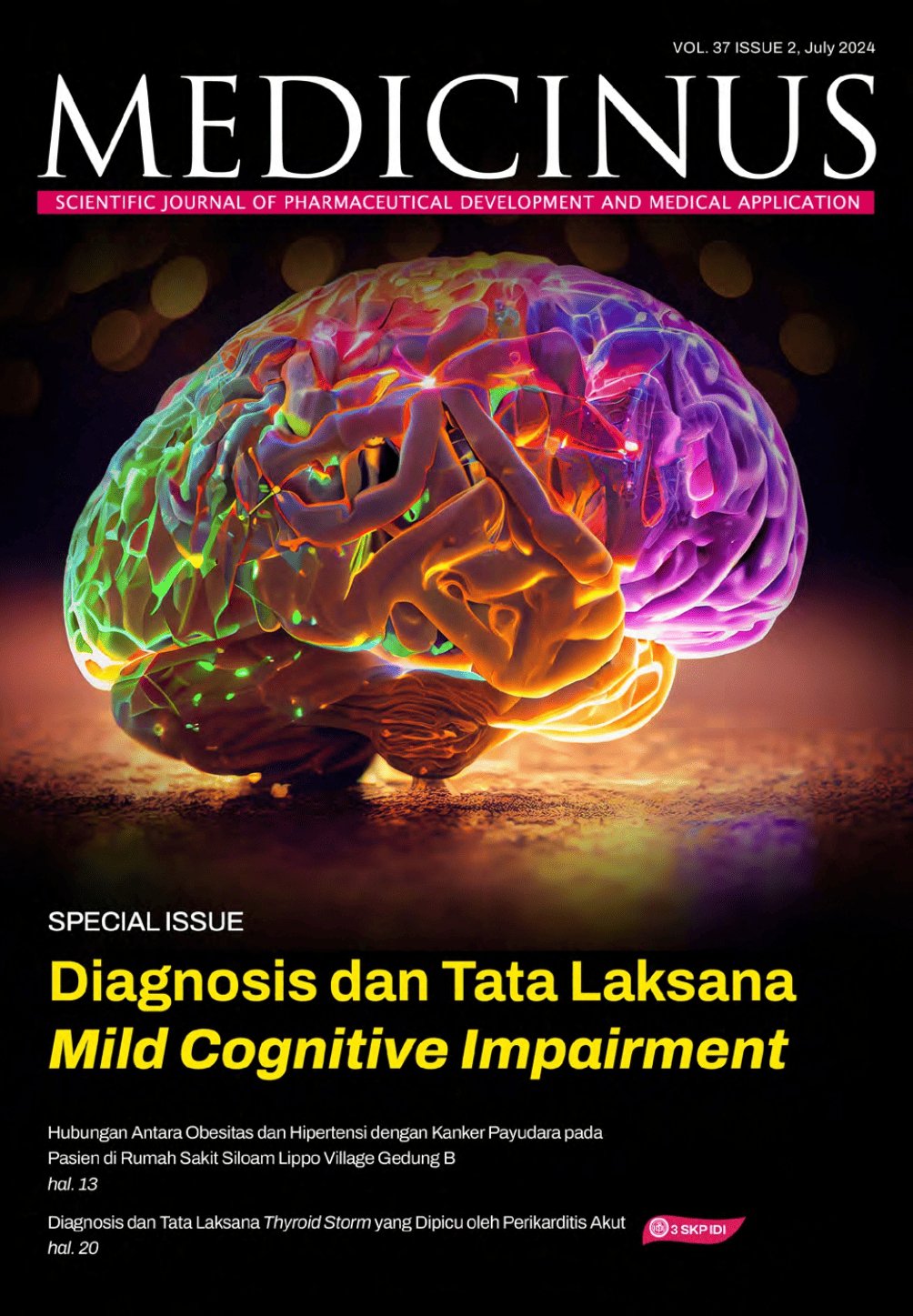Potensi farmakologi Kasumba Turatea (Carthamus tinctorius L.) sebagai antibakteri
DOI:
https://doi.org/10.56951/6zstjd88Kata Kunci:
Carthamus tinctorius L., antibakteri, hydroxysafflor yellow A, antioksidan, ekstrakAbstrak
Kasumba turatea (Carthamus tinctorius L.) merupakan tanaman yang banyak digunakan dalam pengobatan tradisional di Sulawesi Selatan. Kandungan utama dalam bunga C. tinctorius L. adalah hydroxysafflor yellow A yang berfungsi sebagai agen antiinflamasi, antioksidan, dan penghambat agregasi platelet. Tinjauan pustaka ini bertujuan untuk
menganalisis potensi farmakologi C. tinctorius L. sebagai agen antibakteri. Metode yang digunakan melibatkan tinjauan pustaka dari berbagai database seperti PubMed, Google Scholar, dan Scopus. Hasil tinjauan pustaka ini menunjukkan bahwa ekstrak C. tinctorius L. memiliki kemampuan untuk menghambat pertumbuhan berbagai bakteri patogen seperti Listeria monocytogenes, Streptococcus iniae, Staphylococcus aureus, dan Escherichia coli. Senyawa bioaktif seperti carthamin, senyawa fenolik, dan flavonoid menunjukkan aktivitas antibakteri secara in vitro. Selain itu, ekstrak C. tinctorius L. juga memiliki potensi sebagai agen antihelmintik dan antioksidan. Penelitian lebih lanjut diperlukan untuk mengisolasi
dan mengkarakterisasi senyawa bioaktif spesifik serta validasi in vivo dan uji klinik untuk memastikan efektivitas dan keamanannya.
Unduhan
Referensi
Zhou X, Tang L, Xu Y, Zhou G, Wang Z. Towards a better understanding of medicinal uses of Carthamus tinctorius L. in traditional Chinese medicine: A phytochemical and pharmacological review. Journal of Ethnopharmacology 2014;151(1):27-43. doi:10.1016/j.jep.2013.10.050. DOI: https://doi.org/10.1016/j.jep.2013.10.050
Delshad E, Yousefi M, Sasannezhad P, Rakhshandeh H, Ayati Z. Medical uses of Carthamus tinctorius L. (safflower): a comprehensive review from traditional medicine to modern medicine. Electronic Physician 2018;10(4):6672–81. doi:10.19082/6672. DOI: https://doi.org/10.19082/6672
Dixit AK. A review on potential pharmacological uses of Carthamus tinctorius L . World Journal of Pharmaceutical Sciences 2015;3(8):1741-6.
Hansur L, Louisa M, Wuyung PE, Fadilah F. Daphnoretin from Carthamus tinctorius as a potential inflammatory inhibitor in Covid-19 by binding to toll-like receptor-4: an in silico molecular docking study. Open Access Macedonian Journal of Medical Sciences 2022;10:220–27. doi:10.3889/oamjms.2022.7961. DOI: https://doi.org/10.3889/oamjms.2022.7961
Imran A. Isolasi senyawa kimia dari bunga kasumba turate (Carthamus tinctorius). Available at https://repositori.uin-alauddin.ac.id/2236/1/Ali%20Imran.pdf accessed July 9, 2024.
Arpornsuwan T, Petvises S, Thim-uam A, Boondech A. Effects of Carthamus tinctorius L. solvent extracts on anti-proliferation of human colon cancer (SW 620 cell line) via apoptosis and the growth promotion of lymphocytes. Songklanakarin Journal of Science and Technology 2012;34(1):45-51.
Noreen S, Maqbool I, Madni A. Dexamethasone: therapeutic potential, risks, and future projection during Covid-19 pandemic. Eur J Pharmacol. 2021;894:173854. doi: 10.1016/j.ejphar.2021.173854. DOI: https://doi.org/10.1016/j.ejphar.2021.173854
Hansur L and Pawitan J. The potential of hydroxysafflor yellow a as an adjuvant in Covid-19 patients with acute respiratory distress syndrome. International Medical Journal 2021;28(5):527-31.
Dobrin A and Popa G. Evaluation of the antimicrobial activity of Carthamus tinctorius extracts against nosocomial microorganisms. Scientific Papers. Series B Horticulture 2022;66(1):799–806.
Zhang L, Tian K, Tang Z, Chen X, Bian Z, Wang Y, et al. Phytochemistry and pharmacology of Carthamus tinctorius L. American Journal of Chinese Medicine 2016;44(2): 197–226. doi:10.1142/S0192415X16500130. DOI: https://doi.org/10.1142/S0192415X16500130
Ozkan K, Bekiroglu H, Bayram Y, Sagdic O. In vitro bioaccessibility, antioxidant and antibacterial activities of three different safflower (Carthamus tinctorius L.) genotypes. Food Science and Technology (Campinas)
;42(26):1-7. doi:10.1590/fst.08921. DOI: https://doi.org/10.1590/fst.08921
Zargari A, Mazandarani M, Hoseini SM. Effects of safflower (Carthamus tinctorius) extract on serum antibacterial activity of rainbow trout (Oncorhynchus mykiss) against Aeromonas hydrophila, Streptococcus
iniae and Yersinia ruckeri. International Journal of Aquatic Biology 2018;6(1):1–7. doi:10.22034/ijab.v6i1.392.
SJ AR, Ramesh CK, Sathyanarayana R, Mahadevappa P. Dehydroabietylamine, a diterpene from Carthamus tinctorious L. showing antibacterial and anthelmintic effects with computational evidence. Current Computer Aided Drug Design 2019;15(3). doi:10.2174/1573409915666190301142811. DOI: https://doi.org/10.2174/1573409915666190301142811
Khatimah K, Purwanti S, Jamilah J. The antibacterial activity of kasumba turatea (Carthamus tinctorius L.) against Salmonella pullorum and Escherichia coli as an alternative feed additive for poultry. IOP Conference Series Earth and Environmental Science 788(1):012191. doi:10.1088/1755-1315/788/1/012191. DOI: https://doi.org/10.1088/1755-1315/788/1/012191
Karimkhani MM, Shaddel R, Khodaparast MHH, Vazirian M. Antioxidant and antibacterial activity of safflower (Carthamus tinctorius L.) extract from four different cultivars. Quality Assurance and Safety of Crops & Foods 2016;8(4):1-10. doi:10.3920/QAS2015.0676. DOI: https://doi.org/10.3920/QAS2015.0676
Abuova Z, Turgumbayeva A, Jumagaziyeva A, Rakhimov K, Jussupkaliyeva A. Study of component composition and antimicrobial activity of the ophthalmic emulsion based on the safflower flowers (Carthamus tinctorius L.). Int J Microbiol. 2022;2022:3181270. doi: 10.1155/2022/3181270. DOI: https://doi.org/10.1155/2022/3181270
Saeed J, Shah SNH, Javed H, Aslam A, Ali A, Siddique F, et al. Experimental and in silico evaluation of Carthamus tinctorius L. oil emulgel: a promising treatment for bacterial skin infections. Front. Cell. Infect. Microbiol. 2023;13:1253095. doi: 10.3389/fcimb.2023.1253095. DOI: https://doi.org/10.3389/fcimb.2023.1253095
Salem N, Msaada K, Elkahoui S, Mangano G, Azaeiz S, Slimen IB, et al. Evaluation of antibacterial, antifungal, and antioxidant activities of safflower natural dyes during flowering. BioMed Research International 2014(2):762397. doi:10.1155/2014/762397. DOI: https://doi.org/10.1155/2014/762397
Abdulhaq AA. Carthamus tinctorius L. as an antivirulence intervention against methicillin-resistance Staphylococcus aureus. International Journal of Pharmacology 2022;18(6):1219-28. doi: 10.3923/ijp.2022.1219.1228. DOI: https://doi.org/10.3923/ijp.2022.1219.1228
Sulieman AME, Sharawy S, Elghamdi AA, Abdelgadir M. Evaluation of antimicrobial activity of safflower (Carthamus tinctorius) and its synergistic effect with antibiotic. EC Microbiology 2018;14(3):160-6.
Unduhan
Terbitan
Bagian
Diterbitkan
Unduhan
Lisensi
Hak Cipta (c) 2024 Lismayana Hansur, Ami Febriza, Dito Anurogo, Dara Ugi Aras, Endah Dwijayanti

Artikel ini berlisensi Creative Commons Attribution-NonCommercial 4.0 International License.




